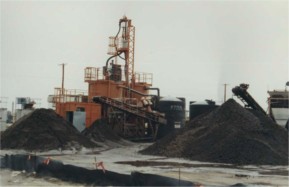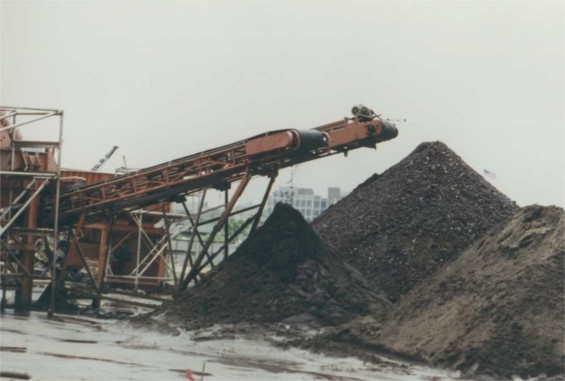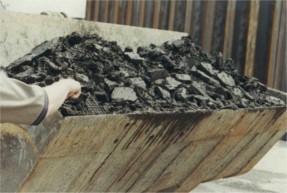Soil Washing and Bioslurry Treatment of Polynuclear Aromatic Hydrocarbon (PAH) and Phthalate Contaminated Soils at Monsanto Brownfields Site
Project Description
The Monsanto Company operated a chemical plant at this 84-acre brownfields site from the mid-1800s to 1992. Manufacturing activities resulted in soil impacted with Polynuclear Aromatic Hydrocarbons (PAH), Naphthalene, BEHP (Bis-Ethyl Hexyl Phthalate) and heavy metal(-s) arsenic, lead and zinc. Since operations ceased, the plant facilities have been dismantled or demolished, and the site was remediated for construction of a 650,000 square foot shopping mall. Monsanto performed the cleanup at this site under the Massachusetts Contingency Plan.
ART began preparations for soil treatment operations in May 1996 with a treatability study to provide data for design of the plant. The study showed that the fines fraction (<2mm) contained BEHP (Bis-Ethyl Hexyl Phthalate), and the oversize fraction (>2mm) contained Polynuclear Aromatic Hydrocarbons (PAH). The process flow diagram design included a trommel, feed hopper, double-decked wet screen, hydrocyclone separation, attrition scrubbing, secondary hydrocycloning, sand dewatering, fines thickening and consolidation, sludge dewatering, and gravity separation (jig) of oversize. The dewatered fines stream were further treated in bioslurry reactor(-s).
 |
 |
 |
Mobile Soil Treatment Plant |
Sand and Gravel Products |
Fines Filter Cake |
ART mobilized a 15 tph soil washing plant to the site and configured it in accordance with the optimized process flow diagram. Soils consisting primarily of oversize and coarse material, with less than 20% silt and clay, including construction debris, demolition rubble and other fill, were excavated from several areas around the site and delivered to the plant for processing. The soil was field-screened to remove gross oversize material, producing a plant feed <2”. This material was fed into the plant and through the wet screening unit, producing a process oversize >2mm, and a wet slurry <2mm. The process oversize, containing PAH, was staged outside the plant for further treatment. The wet slurry was fed to the hydrocyclone separation unit, producing a coarse sand fraction and a fines fraction. The coarse sand fraction was directed to a dewatering screen and, after testing, was returned to the site as clean backfill. The fines fraction was further treated in a bioslurry system for biodegradation of naphthalene and phthalates. The oversize material >2” contaminated with PAH concentrations higher than treatment targets were further treated by attritioning and density separation (jig)..
RETURN to: PROJECT EXPERIENCE
RETURN to: HOME